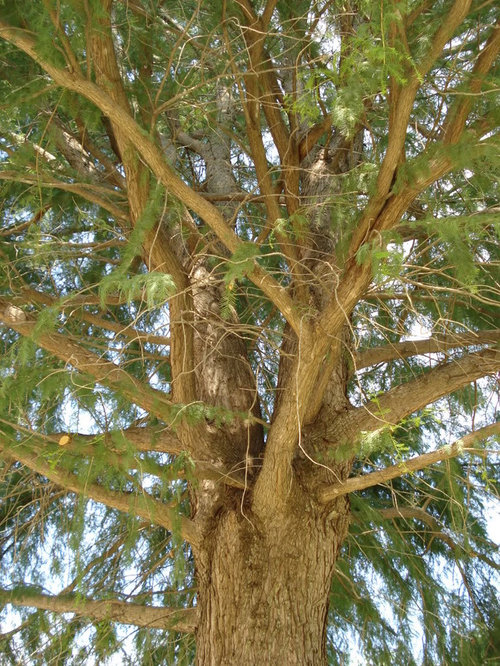I found this tree in another subdivision down the street from my subdivision when I was driving around to see what trees are thriving, etc. I sent a few pictures to a professor at my old college to confirm if it is T. mucronatum aka Montezuma Cypress. In the literature, they are not supposed to thrive this far up north. In fact, they are not supposed to thrive beyond San Antonio. Apparently, it did great against 15*F weather (the coldest I've experienced in this location).
Here are the pictures...
{{gwi:452157}}
There is a bald cypress next door to this tree and it looks pretty bad. I guess chlorosis problem? Just doesn't look good. Then again so do many other bald cypress growing in caliche soil or clay topsoil on top of caliche(limestone) base.
There are some T. Mucronatum growing in New Mexico where the winters are much colder. I have 4 seedling of these with me that were grown from seeds collected there by a nursery in Houston, Texas.
I also have Mucronatum x distichum hybrid seedlings developed by someone in China called Nanjing Beauty. I think they will be eventually introduced to USA one day. I got them from my old college over the summer. :) China is growing millions, millions of them, far more than USA can produce! They also have come up with more hybrids between distichum and ascendens. Also ascendens and mucronatum hybrids. It's a big thing going on over there. It's pretty neat of what China is doing with these cypress species.













justintx
tcharles26
Related Professionals
Arlington Landscape Architects & Landscape Designers · Severn Landscape Architects & Landscape Designers · Vernon Hills Landscape Architects & Landscape Designers · Garden City Landscape Architects & Landscape Designers · Surprise Landscape Contractors · Wakefield Landscape Contractors · Maple Valley Landscape Contractors · Belmont Landscape Contractors · Cupertino Landscape Contractors · Dixon Landscape Contractors · Lynn Landscape Contractors · Manhattan Landscape Contractors · Pleasant Prairie Landscape Contractors · Shaker Heights Landscape Contractors · Wentzville Landscape Contractorsospreynn
lou_spicewood_txOriginal Author
lou_spicewood_txOriginal Author
walter_ernst
lou_spicewood_txOriginal Author
ravendonkey
torreya-2006
ravendonkey
lou_spicewood_txOriginal Author
lou_spicewood_txOriginal Author
kman04
lou_spicewood_txOriginal Author
kman04
kman04
lou_spicewood_txOriginal Author
kman04
lou_spicewood_txOriginal Author
kman04
lou_spicewood_txOriginal Author